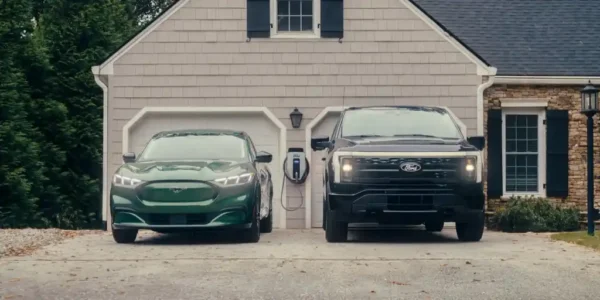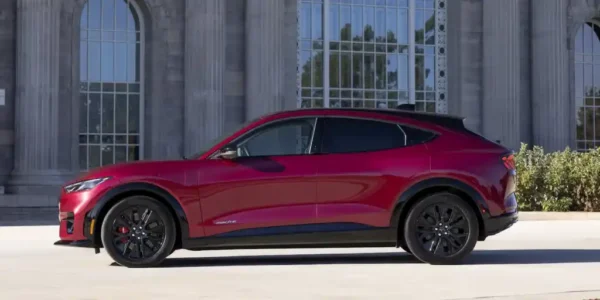Introduction to Ford’s LFP Battery Plant
Ford Motor Company is making significant strides in the electric vehicle (EV) market with the establishment of its new lithium iron phosphate (LFP) battery plant in Marshall, Michigan. This initiative is a vital aspect of Ford’s strategy to produce affordable electric vehicles, which aligns with the growing demand for sustainable transportation solutions. By focusing on LFP battery technology, Ford aims to reduce production costs significantly while ensuring that its EV offerings remain competitive within the global automotive sector.
The LFP battery plant is expected to play a crucial role in lowering the costs associated with electric vehicle battery production. LFP batteries are particularly known for their cost-effectiveness and enhanced safety compared to other battery types such as nickel-cobalt-manganese (NCM). This shift in focus not only reflects Ford’s commitment to expanding its EV lineup but also signifies an intention to enhance domestic battery manufacturing capabilities. The implications of this development are profound, as it could lead to greater accessibility of electric vehicles for a wider audience, ultimately contributing to the growth of the EV market in the United States.
Production at the Marshall facility is anticipated to commence by mid-2026, positioning Ford at the forefront of the electric vehicle revolution. The plant is designed to produce a substantial number of battery units to support Ford’s ambitious EV production goals, which include a target of manufacturing over two million electric vehicles annually by 2026. This timeline demonstrates a clear commitment to not only improving the efficiency of EV production but also ensuring that affordability remains a core focus. In essence, Ford’s LFP battery plant initiative is set to reshape the landscape of electric vehicle production, enhancing the competitiveness of American automotive manufacturing on a global scale.

Timeline for Production and Investment
Ford Motor Company is poised to make substantial advancements in the production of lithium iron phosphate (LFP) batteries, with the initiative aimed at enhancing the affordability of electric vehicles (EVs). The company has earmarked a significant investment of billion to establish its LFP battery plant, which is expected to commence production by 2026. This strategic move underscores Ford’s commitment to offering economically accessible electric vehicles, ensuring they cater to a broader audience in the growing EV market.
The establishment of the LFP battery facility aligns with the ongoing governmental push for sustainable energy solutions, including anticipated federal tax credits designed to incentivize the adoption of electric vehicles. By focusing on LFP technology, Ford is targeting a battery solution recognized for its cost-effectiveness and safety. This is particularly vital as the company plans to manufacture new EV models that will incorporate these advanced batteries, promoting affordability without compromising on performance and reliability.
Investments in the LFP production facility are not only crucial for the company’s future but also have the potential to influence the entire electric vehicle landscape. The ability to produce these batteries on a large scale will significantly reduce production costs, enabling Ford to price their new EV models competitively. Furthermore, by keeping production domestic, Ford aims to strengthen local economies while decreasing dependency on foreign battery suppliers, thereby fostering greater control over the supply chain.
As the timeline approaches 2026, stakeholders within the automotive industry and consumers alike will be watching closely to see how Ford executes its plans. The anticipated launch of their new electric vehicle models, powered by LFP batteries, could mark a pivotal shift in the approach to making electric vehicles more accessible to the average consumer.
Political Landscape and Challenges
The political environment surrounding electric vehicles (EVs) and battery manufacturing has become increasingly contentious, particularly during the current administration. Ford Motor Company’s commitment to establishing its Lithium Iron Phosphate (LFP) battery plant is influenced significantly by the prevailing political landscape, especially given the challenges posed by opposition from specific factions within the government. Notably, the Trump administration and its supporters have often advocated for cuts to federal incentives aimed at promoting EV adoption and the expansion of battery production capabilities.
These political dynamics could create substantial hurdles for Ford’s LFP battery initiative. As debates unfold in Congress regarding funding for clean energy programs, the fate of incentives that support EV manufacturers, including those designed to bolster battery facility construction, remains uncertain. Without robust governmental backing, companies like Ford may find it challenging to secure the necessary financial resources and incentives to make their ambitious projects financially viable. This uncertainty highlights the importance of political advocacy and engagement with lawmakers to ensure alignment with the firm’s strategic goals for EV manufacturing.
Furthermore, the prospect of shifting political administrations has raised concerns regarding the long-term sustainability of support for EV initiatives. Corporations investing in electric vehicle technology face a complex landscape wherein policy changes can dramatically alter market conditions, affecting not only funding avenues but also consumer protection measures designed to facilitate the transition to sustainable transportation. As Ford seeks to forge ahead with its LFP battery plant, the interplay of political factors will undoubtedly play a pivotal role in shaping the future of its operations and the broader EV market in the United States.

Technological Partnerships with CATL
Ford’s commitment to affordable electric vehicles (EVs) has led to a significant partnership with Contemporary Amperex Technology Co. Limited (CATL), a leading Chinese manufacturer of lithium-ion batteries. This collaboration is centered around leveraging CATL’s advanced battery technology to enhance the performance and cost-effectiveness of Ford’s EV lineup. By embracing this partnership, Ford aims to secure a steady supply of high-quality batteries that are essential for its ambitious electric vehicle production goals, particularly in the context of the growing demand for cleaner transportation solutions.
The decision to license technology from an international partner like CATL brings certain advantages for Ford. Primarily, it allows Ford to capitalize on CATL’s expertise in battery chemistry and manufacturing processes, which can expedite the development of cutting-edge battery technologies, including lithium iron phosphate (LFP) batteries. These batteries are not only known for their safety and longevity but also for their potential cost savings, which aligns perfectly with Ford’s objective of making EVs affordable for a broader customer base.
However, this partnership does not come without its vulnerabilities. Relying on foreign technology can expose Ford to various geopolitical and supply chain risks, particularly as regulatory environments evolve. The increasing scrutiny on international partnerships, coupled with a push for domestic production, poses challenges for automakers like Ford. In response to these pressures, Ford has announced plans to invest in domestic battery manufacturing facilities to complement its collaboration with CATL. This dual approach aims to bolster supply chain resilience while also adhering to regulatory mandate for localization in the electric vehicle sector.
Ultimately, Ford’s strategic partnership with CATL reflects a careful balance between leveraging international expertise and fostering domestic capabilities, ensuring the company’s long-term viability in the rapidly evolving electric vehicle market.
Impact on Employment and Local Economy
The establishment of Ford’s LFP battery plant is projected to generate approximately 1,700 new jobs, significantly impacting the local economy in Michigan. These positions span a wide range of roles, from skilled technicians and engineers to operational and administrative staff, reflecting the diverse needs of a modern manufacturing facility. The creation of high-quality jobs is especially crucial in an era where manufacturing positions are vital for sustaining the economic fabric of local communities.
One of the key factors associated with these new job opportunities is the emphasis on retaining and enhancing skilled labor within the U.S. manufacturing sector. As Ford continues to innovate and embrace electric vehicle technology, the demand for skilled workers becomes paramount. The ability to provide training and upskilling programs can help to ensure that the workforce is adequately prepared to meet the challenges associated with advanced manufacturing processes, especially as they relate to battery production for electric vehicles.
The economic implications of job creation extend beyond the immediate employment figures. Increased employment opportunities will contribute to a boost in local spending, as newly employed residents begin to engage more actively with the economy. This surge in local commerce can lead to an increase in demand for services and goods, fostering a ripple effect throughout the community. Moreover, with the influx of higher-paying jobs associated with the LFP battery plant, there is potential for improved quality of life for many families in the region.
In summary, the creation of 1,700 jobs linked to Ford’s LFP battery plant not only holds promise for individual economic uplift but also represents a broader commitment to maintaining and enhancing the skilled labor pool necessary for future manufacturing paradigms in the United States. The synergy between job creation and economic growth positions Michigan as a central player in the evolution of the electric vehicle landscape.
Ford’s Vision for Affordable Electric Vehicles
Ford has long recognized the crucial role electric vehicles (EVs) will play in the future of transportation, and the company is strategically positioned to lead the charge toward affordability. The company’s commitment is evident in its ambitious plan to develop a range of accessible EV options for consumers. According to company executives, including Chief Operating Officer Lisa Drake, the integration of Lithium Iron Phosphate (LFP) batteries into Ford’s vehicle lineup is a pivotal step in this direction.
LFP batteries are celebrated for their cost-effectiveness and safety, characteristics essential for lowering the price of electric vehicles without compromising quality or performance. Ford’s leadership has highlighted that by investing in LFP battery technology, the company can achieve significant reductions in manufacturing costs. This will not only enable Ford to offer more competitively priced EVs but also democratize access to electric transportation for a broader segment of the population. The focus on affordability is not simply a strategic business decision; it reflects Ford’s commitment to a sustainable future.
Moreover, this initiative aligns with Ford’s broader electrification strategy, which includes a substantial investment in research and development aimed at enhancing battery technology and expanding charging infrastructure. Executives have repeatedly emphasized that as the world transitions to electric mobility, affordability will be a key factor influencing consumer decisions. Ford aims to ensure that its EV offerings are not only accessible but also appealing to a wide range of customers, enhancing the acceptance of electric vehicles across various markets.
As Ford continues to innovate and adapt to changing market dynamics, the focus on LFP batteries serves as a cornerstone of its mission to create a sustainable future driven by affordable electric mobility. This commitment exemplifies Ford’s proactive approach to navigating the evolving automotive landscape while prioritizing customer needs and environmental responsibilities.
Current Production Status and Future Plans
As part of its strategy to enhance its electric vehicle (EV) offerings, Ford continues to make significant advancements in the production of lithium iron phosphate (LFP) batteries. These batteries, known for their cost-effectiveness and safety, are becoming an integral component of Ford’s upcoming EV programs. Currently, Ford has commenced the production of c-sample battery cells at a dedicated facility, which marks a critical step toward establishing its LFP battery manufacturing capabilities. The production of these prototype batteries is not merely a preliminary action; it serves to validate the technical approach and performance criteria needed for mass production.
Ford’s current production focus involves refining the manufacturing process to ensure scalability and efficiency. Engineers are actively working on improving the design and performance of these LFP batteries to meet the diverse needs of consumers. The ongoing production of these cells is proving beneficial, providing valuable data and insights that will inform future battery developments and designs. This commitment to rigorous testing and validation highlights Ford’s strategy of prioritizing quality and performance in its electric vehicle offerings.
Looking ahead, Ford has outlined ambitious plans to ramp up production capabilities within the next few years. The company aims to establish a fully operational LFP battery plant by 2025. This facility is expected to significantly increase production volume, thereby supporting Ford’s broader objective of making EVs more affordable and accessible to the general public. Alongside this, Ford plans to invest in enhancing its supply chain to ensure the availability of essential materials for LFP battery production. Overall, the combination of these ongoing efforts and future initiatives positions Ford as a leader in the EV market, committed to innovation and sustainability.
Industry Reactions and Comparisons
Ford’s strategic move to establish an LFP (Lithium Iron Phosphate) battery plant has garnered substantial attention from various industry analysts and stakeholders. This initiative represents a critical step in the automaker’s commitment to producing affordable electric vehicles (EVs), a sector that continues to gain momentum. Industry experts such as Daniel Roeska, a prominent analyst in the automotive field, have provided insightful reactions regarding Ford’s efforts to enhance its battery production and cost efficiency. Roeska asserts that the LFP batteries are poised to create a more cost-effective alternative to traditional lithium-ion batteries, which would significantly lower the overall price of Ford’s EVs.
Comparatively, Ford’s approach mirrors the strategies employed by leading Chinese automotive manufacturers, which have successfully leveraged LFP technology to dominate the EV market by offering vehicles at competitive prices. These manufacturers, such as BYD and CATL, have set a high standard for battery production, focusing not only on cost reduction but also on sustainability. By investing in domestic LFP production, Ford aims to meet similar efficiency metrics while reducing its reliance on costly raw materials that are subject to market fluctuations.
The comparisons extend beyond just battery technology; analysts highlight that Ford’s supply chain strategies could further align its operations with those of its Chinese counterparts. By vertical integration in battery production, Ford potentially stands to benefit from reduced manufacturing costs and enhanced control over its supply chain. This strategic alignment indicates that Ford not only aspires to be a leader in the U.S. EV market but is also keenly aware of the competitive landscape shaped by its international rivals. Overall, the industry’s reception to Ford’s LFP battery initiative reflects an optimistic outlook, positioning the company as a formidable player in the evolving landscape of electric mobility.
Conclusion: The Road Ahead for Ford and U.S. EV Market
As we reflect on Ford’s strategic commitment to the establishment of its LFP battery plant, it becomes evident that the company’s endeavor signals a transformative phase in the electric vehicle (EV) landscape. The investment in lithium iron phosphate (LFP) battery technology represents not only a significant advancement in automotive innovation but also a crucial step toward enhancing the accessibility of electric vehicles for a broader consumer base. Ford’s focus on affordable EVs is commendable, particularly in an era where the demand for sustainable transportation solutions is escalating.
Furthermore, the implications of this initiative extend beyond Ford’s operational framework; they reverberate throughout the entire U.S. automotive industry. By utilizing LFP batteries, known for their cost-effectiveness and safety advantages, Ford is positioning itself as a leader in the transition to electric mobility. This strategy not only addresses pressing consumer needs—including affordability and range anxiety—but also aligns with global sustainability goals aimed at reducing carbon emissions from the transportation sector.
However, the journey ahead is not without its challenges. As Ford navigates the complexities of scaling production and addressing supply chain constraints, the agility to adapt to market dynamics will be crucial. The company’s ability to balance cost management with innovation will ultimately define its success in this competitive arena. In addition, the implications for job creation and economic growth in the regions hosting the new battery plant further underscore Ford’s role as a pivotal player in the U.S. green economy.
In conclusion, Ford’s commitment to developing the LFP battery plant not only highlights its focus on affordable electric vehicles but also showcases its strategic initiative to redefine the future of transportation in America. The long-term impact on both the company and the broader automotive landscape could pave the way for a more sustainable, electrified future in the U.S. market.




